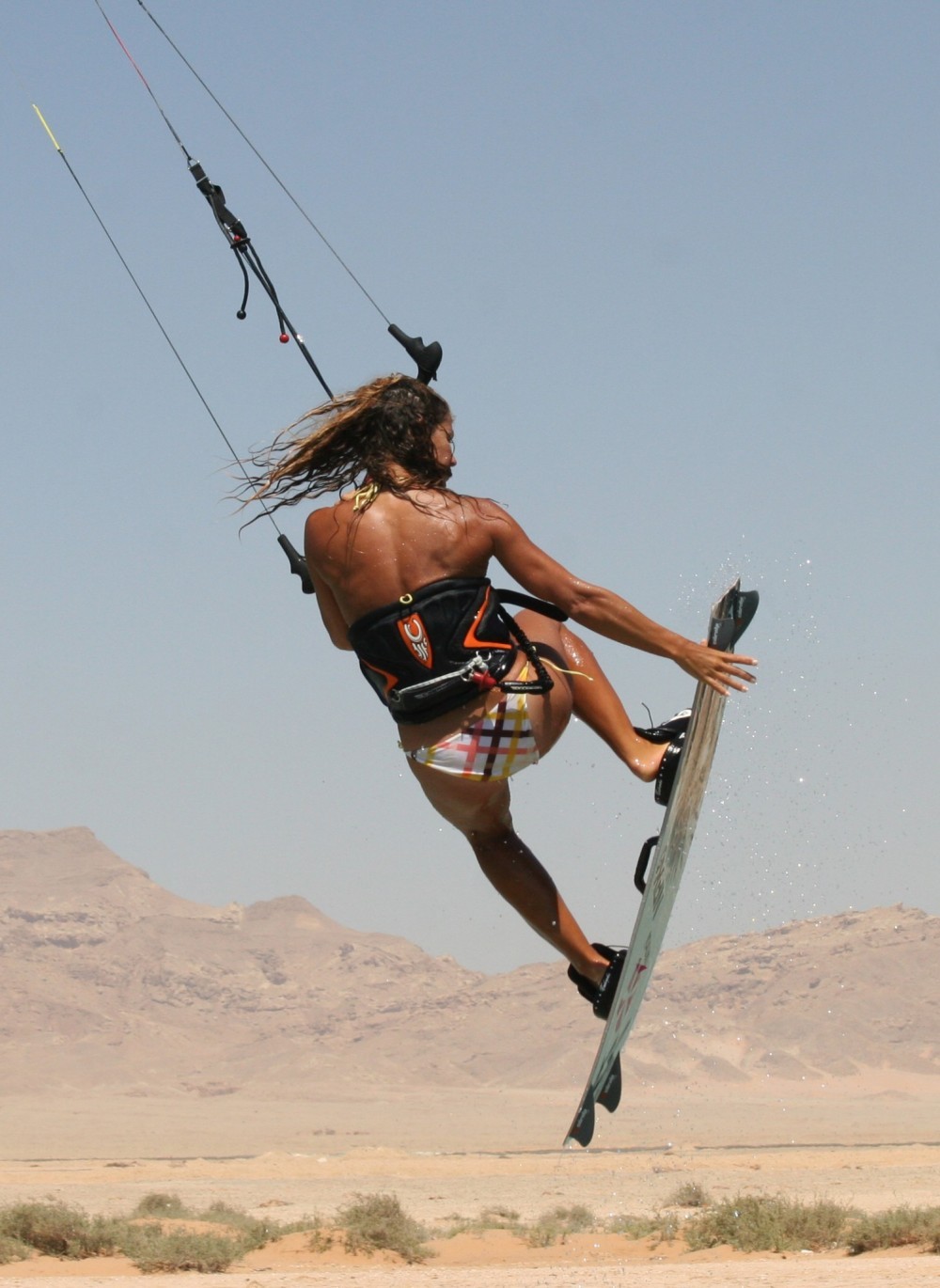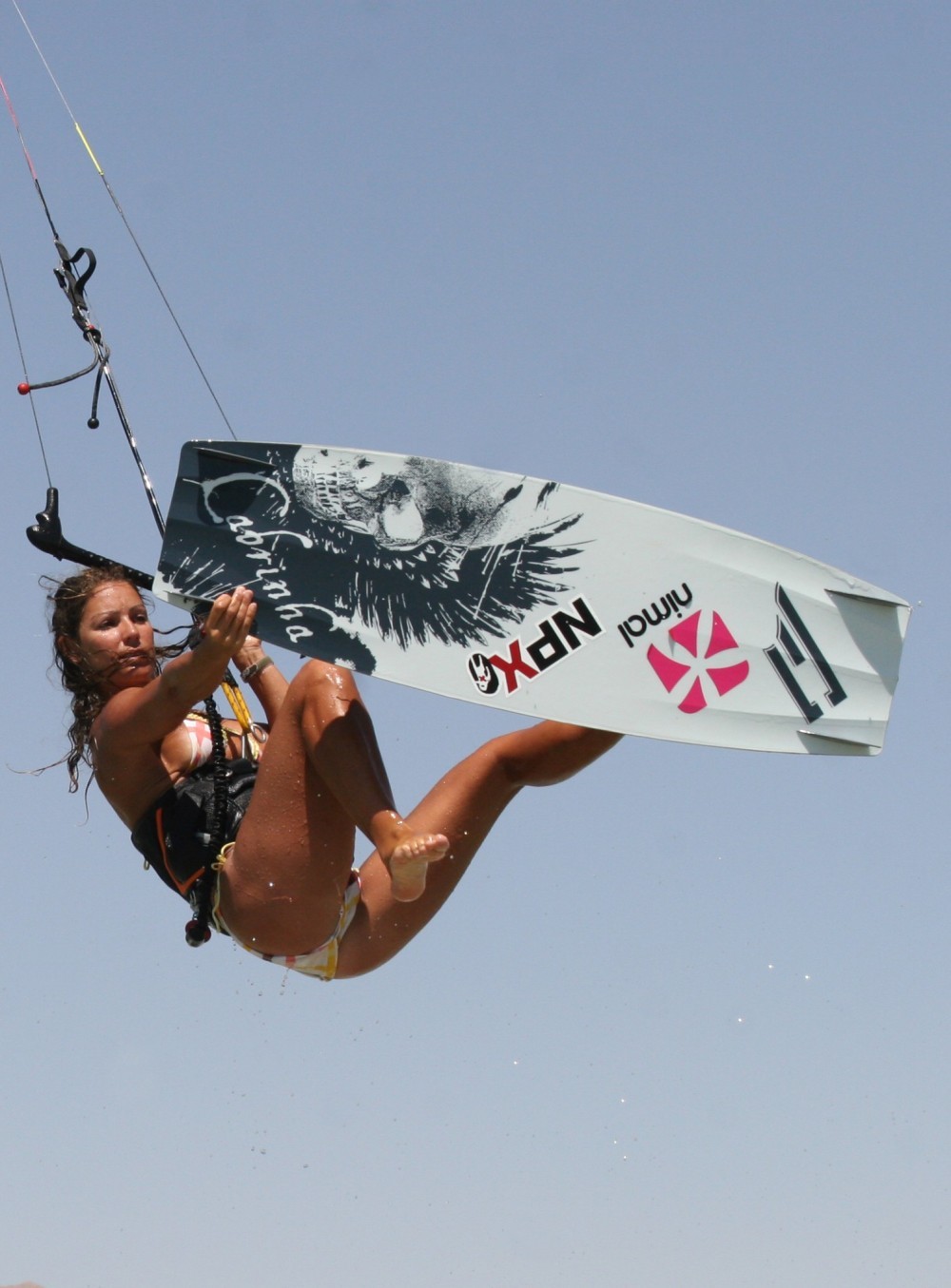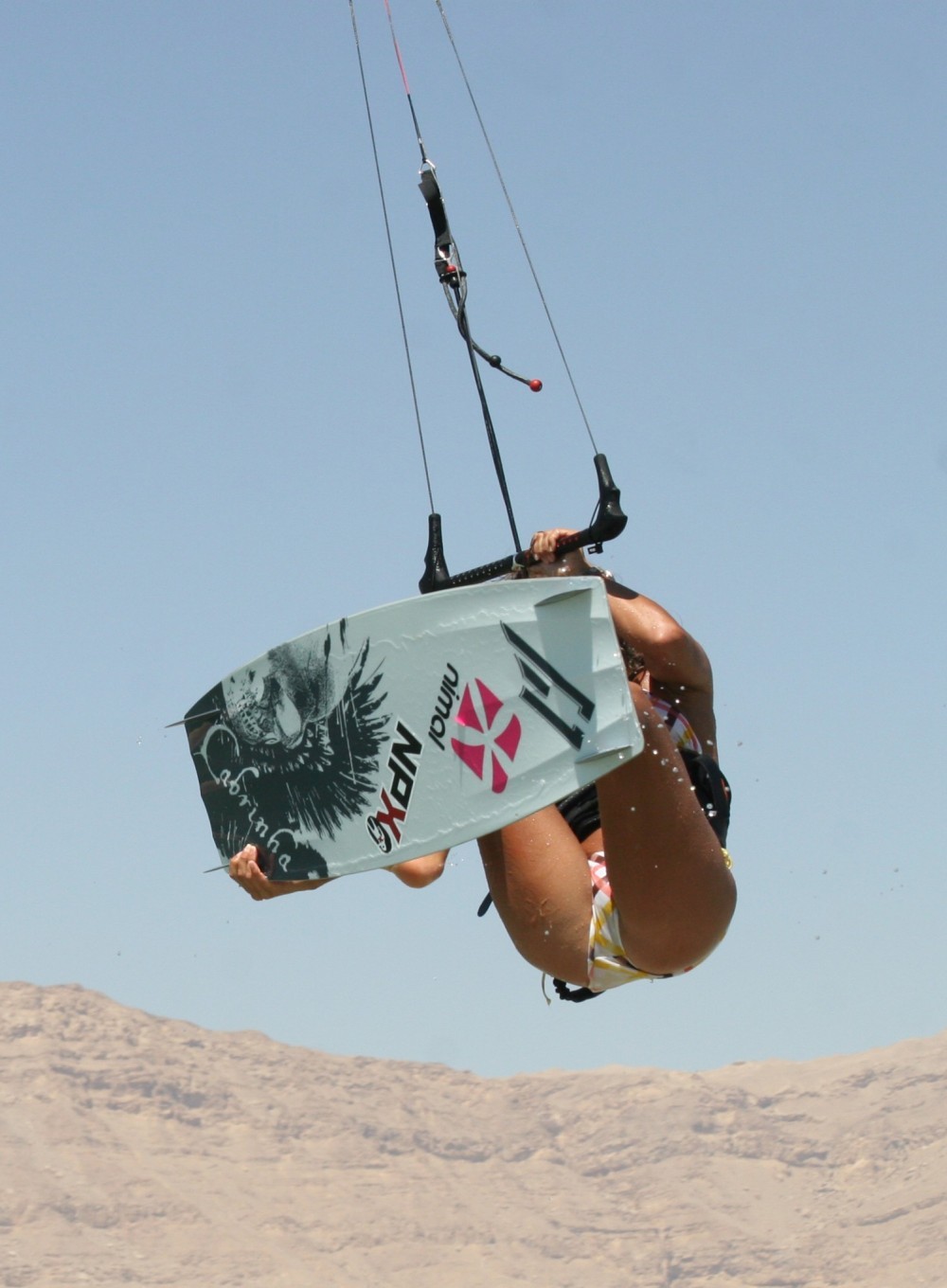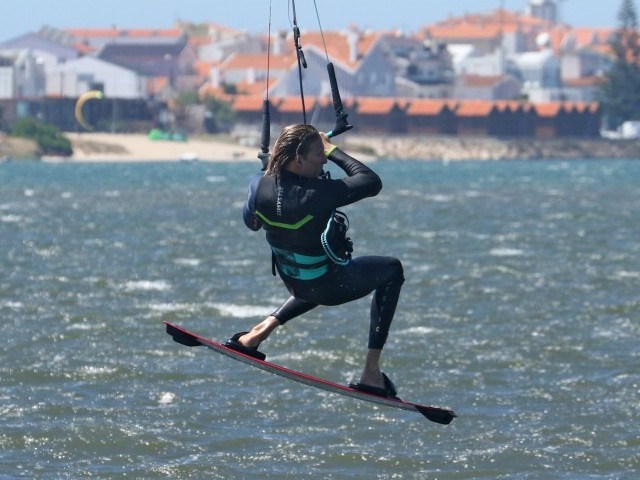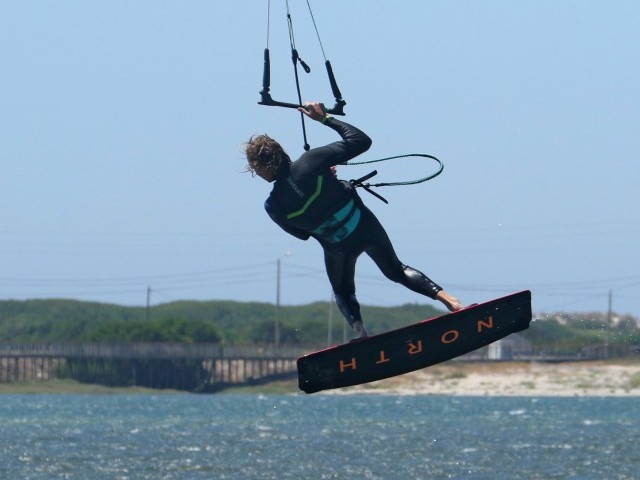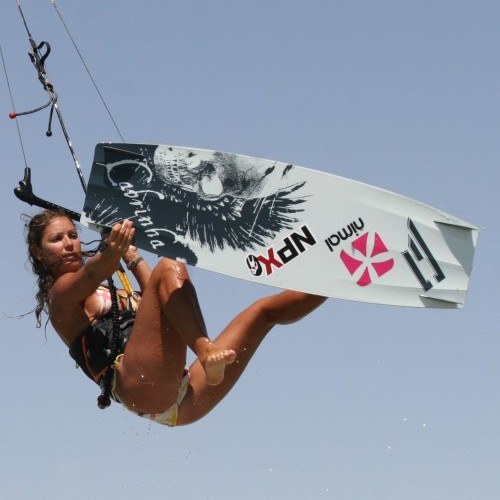
One Footed Front Loop
Technique / Intermediate
Introduction
Before going any further we’ll start by saying that if you’re about to try this then we assume that you already know how to front loop. Therefore we don’t need to painstakingly go through the front loop again, but rather just touch on the important bits and pieces that will make this work. If you need refreshing look back to issue 2.
So knowing that you can front loop is enough. You don’t need to be able to do a one-footed jump, as some people actually find it easier to take a foot out whilst rotating. However you will need to start by doing tail grabs with you back hand whist front looping. This will give you the feeling and confidence to take it that bit further. On top of that to get the muscle memory working you can sit on the end of your bed and practice taking your foot out and sliding it back in.
Those Important Bits
Pic A. shows Karine immediately after take off, as she is about to execute a wonderful one-foot forward. Things to note in this picture starting from the top:
Having only just taken off Karine has already committed to redirecting the kite with her front hand. She has done this because she wants to have enough time in the air to complete the move, and with the kite moving forward she will get more hang time. Also as is the nature of a front loop, because she threw herself forwards into the rotation, she will have released her edge a bit early. This means that there is always a chance for the kite to end up behind her, so better safe than sorry.
She is looking at what she is doing. She aims to grab the board on the heelside edge in front of the fin. It’s much easier to grab the board where you want if you’re looking at it, Karine is. Fortunately because her back hand is behind her, this helps the rotation too.
Karine’s back knee is really bent. She has pulled the board up to her, rather than leant down to the board. This way it’ll be easier to get her foot out, and because she’s not bent over double it’ll be easier to feel and control the kite.
Finally you may have noticed from her lines that she has not turned very far yet. However she has already gone for the grab. Karine has committed to the move from the off and has gone for it immediately after take off. If she waited to judge if she had enough height, or if anyone was looking she would miss the opportunity and fluff the move.
Pic B. Karine is exactly half way through her rotation, and has her foot out. She has the bar pulled right in to keep tension in the lines and thus give her float. This also means that the kite is still moving forward across the window, keeping her up there. Her toes are pointing up to the heavens, so the board is in a position from which her foot can easily slide out.
Karine has a good grip on the board with her back hand, and is supporting the board with this hand and her other foot, which she has lifted in front of her. So rather than bending forward she is almost leaning back, lifting the board up with her back hand and lifting her legs. This puts her board onto its side so she can easily drop her foot out, with the help of gravity, rather than pry it out of a board that is flat in the air. When she takes her foot out Karine tries to push it down towards the water, this way the board does not obstruct her. She is still looking at where her foot came from and will go back to.
Pic C. As Karine comes around her rotation and starts to drop, its time for her to get her pinkies back in the strap. She still has her bar pulled in but is not steering the kite aggressively down.
With the board held up and on its side with her hand and front foot easily in view, Karine can effortlessly slide her back foot into the strap. With the board in this position its weight will push her foot further into the strap when she releases her back hand. Once the board is back on she can concentrate on diving the kite and landing, either with just the front hand on the bar or both.
Final Pointers
If you ride with tight footstraps, loosen the back one a tad as you want to be sliding your foot out, not levering it out with a crow bar.
When you first go out to try this build up to it by doing a few front loops, then some front loop grabs, and then finally get your foot out.
And remember that when you start doing this just sneaking the back foot out and sliding it back in will suffice. Only with a bit of practice will you feel comfortable enough to extend you back leg fully and leave it there dangling in the wind for all to see.
To give yourself more time and float it will be simpler to first learn this using a larger kite in lighter airs rather than a 7m when its balistico.
Following Sequence 1
- Pic 1. As per a normal front loop Karine approaches with good speed, sends her kite back hard and resists will all her might by driving against her legs and carving the board up away from the kite.
- Pic 2. As she feels the kite begin to lift her she commits to the front loop and starts to move her weight forward.
- Pic 3. Karine does this by stamping down hard on her back foot, extending her back leg violently and throwing her head and shoulders towards the front of the board. As she does this she also redirects the kite forward by pulling on her front hand.
- Pic 4. As soon as she is airborne Karine pulls her knees up and the board towards her and releases her back hand.
- Pic 5. Karine looks to where she wants to grab and reaches down with her back hand, keeping the bar in and leaning her weight back.
- Pic 6. In this position she wastes no time and keeping her arm extended to give her room she slides her back foot out, Eureka.
- Pic 7. For extra style points and because she can, Karine extends her leg by pushing it down towards the water, not towards the board. She still has the bar in and is therefore still comfortably flying.
- Pic 8. Knowing that she has to finish the rotation and get her foot back in the strap, and that its been out long enough to be seen, Karine lifts her foot towards the board.
- Pic 9. Still keeping the bar in Karine slots her foot back in the strap.
- Pic 10. As she comes around her rotation, and with her toes in the strap, Karine can now focus on where she’ll be landing.
- Pic 11. Karine releases her back hand from the board and dives the kite hard to pull her out of the rotation.
- Pic 12. As she lands her foot slides the rest of the way into the strap. She can now make sure her kite is moving forward and then untwist her lines.
Common Problems
The most common mistake made by kiters learning this is not keeping tension on the lines. If you let the bar go out as you jump, the kite will end up behind you and you will drop out of the sky as you rotate around. You must keep the bar in, and redirect the kite forward to give yourself the much-required float.
If you lift the board up behind you so that you are grabbing the board under your bum with your toes pointing down you’ll never get the foot out. Practice rolling back on the beach, in bed or in the garden, and you’ll see that with the board held high in you back hand and supported by the front leg your back foot will come out considerably quicker than George Michael.
If you feel that there is no time in your rotation to get your foot out, you need to slow your spin. If you focus upwind as you come through 180˚ you will rotate slower and have time.
Keystones
- Redirect Kite with bar in
- Hand down, board up
- Look
- Lean back, toes skyward
- Push foot down towards the water
This technique article was in Issue 17 of IKSURFMAG.
Related
By Christian and Karine
Christian and Karine have been working together as a coaching team, running improver to advanced kitesurfing clinics since 2003.





